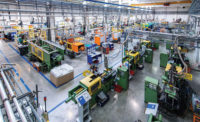WASHINGTON-"External, non-production costs add approximately 22% to unit labor costs of U.S. manufacturers (nearly $5 per hour worked) relative to their major foreign competitors, and are the primary competitive challenge facing manufacturers and their workers," says Jerry Jasinowski, president of the National Association of Manufacturers (NAM).
The finding is part of a new study, "How Structural Costs Imposed on U.S. Manufacturers Harm Workers and Threaten Competitiveness," by economist Jeremy A. Leonard. Funded by Emerson (St. Louis), a manufacturer of industrial equipment, the study was released by the NAM and the Manufacturers Alliance/MAPI.
"Severe global competition has caused manufacturing product prices to decline for the past seven years while non-production costs are skyrocketing," Jasinowski says. "A recent survey of the NAM board of directors found that these extra costs are the number one competitive challenge facing manufacturers, reducing investment, innovation and job creation. We are essentially shooting ourselves in the foot competitively by making it too expensive to make products in America.
"This report comprehensively documents these extra costs-corporate tax rates, employee benefits, tort litigation, regulatory compliance and energy-and estimates them at approximately 22% of the price of production for U.S. firms relative to our nine most important trade competitors," Jasinowski says. "These external costs are twice the size of the average direct labor costs of U.S. manufacturers, and are a major factor in our loss of trade and jobs."
Thomas J. Duesterberg, president and chief executive officer of the Manufacturers Alliance/MAPI, says the study provides a comprehensive analysis of the unique cost burden carried by U.S. manufacturers. "Now that the magnitude of these underlying costs pressures is understood, it is important that federal and state officials begin to address them with new pro-manufacturing policies," he says. "Foremost among these should be tax, regulatory, health and legal reforms."
The Leonard study introduces a "raw cost index" for manufacturers that compares the competitiveness of U.S. producers with those in its nine largest trading partners, and compares costs before and after the cost multipliers have been weighed. "This study dispels the myth that most of our industrialized partners face higher manufacturing costs than we do," Leonard says. "Shifts in international trade trends have generally been masked, and our report shows that American trade is increasing with developing countries where production costs are considerably lower than in the United States. Our corporate tax burden is heavier than in eight of our nine largest trading partners, and pollution- abatement costs are significantly higher than in most other developed countries, including the so-called ‘green' economies of Western Europe."
"U.S. manufacturing has demonstrated the ability to overcome pure wage differentials with trading partners through innovation, capital investment and productivity," says James Berges, president of Emerson. "But when the additional external costs described in this paper are piled on, the task becomes unmanageable, even in the best companies."
Jasinowski complains that many "self-proclaimed" friends of manufacturing are nowhere to be seen when these excessive nonproduction costs are on the table. "Taken together, external nonproduction costs have offset a large part of the 54% increase in productivity achieved since 1990. It is imperative that our elected representatives at all levels take a hard look at the costs created by their actions-and sometimes lack of action-and the impact on our economy. We simply must forge a more pro-worker, pro-manufacturing climate if our industrial leadership is to be maintained and strengthened."


